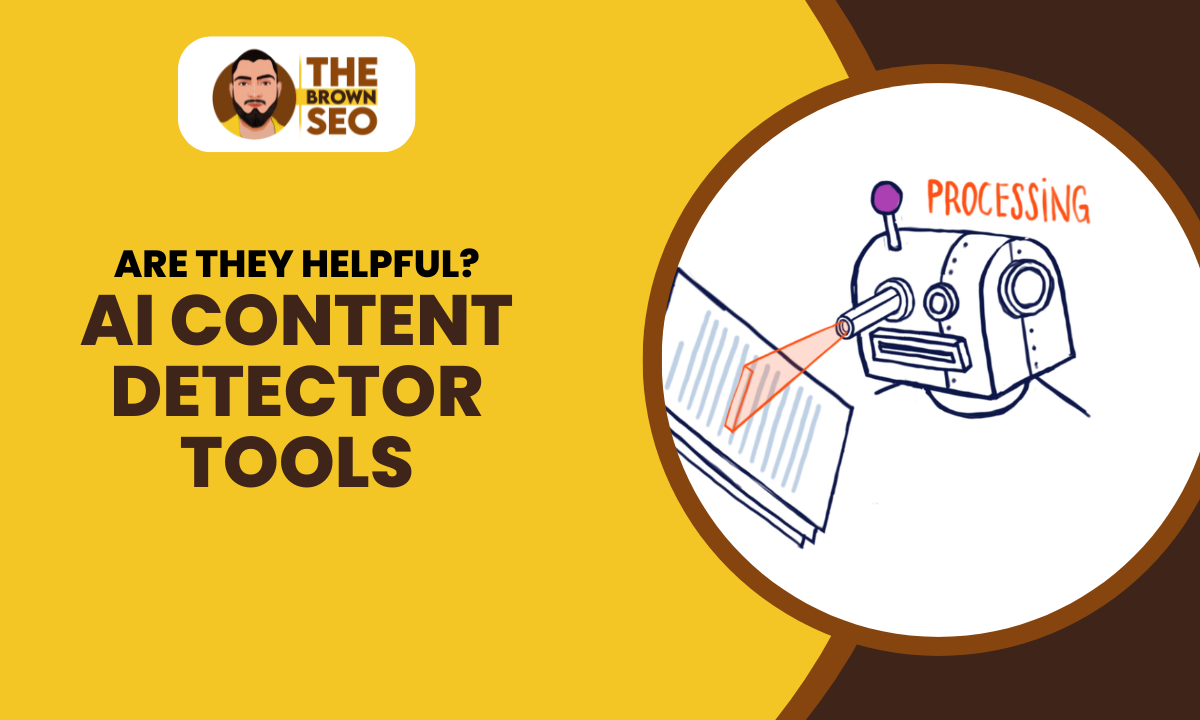
As artificial intelligence (AI) continues to revolutionize various industries, the world of content creation is experiencing a seismic shift.
AI-generated content, once a novel concept, is now commonplace, powering everything from blog posts and news articles to product descriptions and even creative writing. However, the rise of AI-generated content brings its own set of challenges, particularly around issues of originality, credibility, and misinformation.
This is where AI content detector tools come into play. These tools are designed to identify and analyze AI-generated content, providing a crucial checkpoint in maintaining the authenticity of the information we consume daily.
But are these tools truly as effective and helpful as we hope? In this article, we delve deep into whether AI content detector tools are genuinely helpful, how they work, and if they can be relied upon to protect content integrity.
What Are AI Content Detector Tools?
AI content detector tools are specialized software applications that use advanced algorithms to identify whether a piece of content—text, images, videos, or audio—has been generated or heavily influenced by artificial intelligence.
These tools serve as gatekeepers in an age where distinguishing between human and AI-generated content is increasingly difficult. They are widely used across various sectors, including academia, journalism, digital marketing, and social media moderation.
For instance, educational institutions use these tools to ensure students submit original work, while media companies deploy them to verify the authenticity of news articles before publication. Essentially, these tools help preserve the integrity of content by distinguishing between human creativity and machine-generated output.
How Do AI Content Detectors Work?
AI content detectors operate through a combination of complex algorithms and machine learning models. Understanding their working mechanisms can provide insight into their strengths and limitations:
Natural Language Processing (NLP)
NLP is a branch of AI that enables computers to understand, interpret, and generate human language. AI content detectors use NLP to dissect the structure of a text, looking at syntax, semantics, and overall coherence. This analysis helps the tool recognize patterns that are typical of AI-generated text, such as repetitive phrasing or unnatural sentence construction.
Machine Learning Models
These models are trained on vast datasets containing examples of both human-written and AI-generated content. Through this training, the models learn to detect subtle differences between the two, such as the robotic precision of language often found in AI writing compared to the nuanced, sometimes imperfect style of human authors.
Statistical Analysis
AI detectors use statistical methods to analyze the frequency and arrangement of words and phrases. For example, they may identify an unusual distribution of sentence lengths or overly formal language that is atypical for the content’s context. This statistical profiling helps pinpoint AI influences.
Metadata Analysis
Beyond the content itself, AI detectors often examine metadata, such as authorship information, timestamps, and editing history. This additional layer of analysis helps determine the likelihood of AI involvement, especially in cases where content appears highly polished but lacks a clear human author.
These combined approaches allow AI content detectors to scrutinize content meticulously, providing insights into its origin and authenticity.
Types of AI Content Detector Tools
There is a diverse range of AI content detector tools available today, each tailored to specific types of content and use cases. Here’s a look at the most common types:
- Plagiarism Checkers: These tools, like Turnitin and Copyscape, have integrated AI detection capabilities that go beyond simple plagiarism checking. They analyze content to identify whether it might have been generated by AI, helping educators and publishers ensure the originality of submitted work.
- AI Writing Detectors: Tools such as GPTZero and Originality.ai are specifically designed to identify content produced by AI writing models like GPT-3 and GPT-4. They evaluate text for machine-generated characteristics, helping users identify AI-created articles, essays, and reports.
- Image and Video Authenticity Tools: With the rise of AI-generated images and deepfakes, tools like Deepware and Sensity AI focus on detecting manipulated visual content. These tools analyze visual artifacts and inconsistencies to differentiate between real and AI-generated media.
- Social Media Content Moderators: AI content detectors are also used by platforms like Facebook and Twitter to monitor and flag AI-generated content, such as fake news, misleading advertisements, and synthetic media designed to manipulate public opinion.
The Rise of AI-Generated Content
The advent of sophisticated AI models such as GPT, DALL-E, and Midjourney has made generating human-like content more accessible than ever. While this technological leap has its benefits, it also poses challenges, such as the proliferation of misinformation, plagiarism, and content saturation.
AI-generated content can be difficult to distinguish from human-created work, which makes the role of AI content detectors crucial. These tools serve as the first line of defense, ensuring that content remains authentic, original, and trustworthy, especially in industries where content quality is critical.
The Benefits of AI Content Detector Tools
AI content detector tools can be extremely useful, particularly for publishers, educational institutions, and businesses that want to maintain content integrity and ensure authenticity. Here are some of the key benefits:
Safeguarding Content Authenticity
One of the most significant advantages of AI content detector tools is their ability to ensure that the content being published is authentic. Businesses that rely on human creativity and innovation can use these tools to verify that their content is not simply a product of a machine, thereby maintaining originality.
Avoiding Search Engine Penalties
Google and other search engines have been explicit about their preference for high-quality, human-written content. Over-reliance on AI-generated content can lead to lower rankings or even penalties. AI content detector tools can help identify machine-generated content before it gets flagged by search engines, thus protecting websites from SEO repercussions.
Protecting Intellectual Property
For academic institutions, plagiarism and the use of AI in creating assignments are growing concerns. AI content detectors can assist in identifying whether students have used AI-generated text in their submissions, helping uphold academic integrity.
Ensuring Content Quality
AI-generated content, while efficient, can sometimes lack the depth, emotion, and nuance that human writing offers. By flagging AI-created text, content creators can ensure their work meets the required quality standards and resonates with readers on a more personal level.
The Limitations of AI Content Detector Tools
While these tools offer several benefits, they also come with limitations that users must be aware of.
False Positives and Negatives
AI content detectors aren’t foolproof. There are instances where human-created content might be flagged as AI-generated, leading to false positives. Similarly, sophisticated AI content may slip through undetected, resulting in false negatives. These inaccuracies can cause confusion and impact decision-making processes.
Dependence on Training Data
AI detectors rely heavily on their training data. If the models haven’t been adequately trained on a diverse range of writing styles, they may struggle to accurately distinguish between human and machine-written content. As AI-generated text becomes more sophisticated, detector tools must constantly evolve to keep up.
Limited Adaptability to Mixed Content
In many cases, content creators blend AI-generated and human-written text. AI content detector tools may struggle to handle this hybrid content, potentially labeling entire pieces as AI-written when only a portion has been machine-generated.
Are AI Content Detector Tools Reliable?
The reliability of AI content detector tools varies widely based on the tool, its underlying technology, and the type of content being analyzed. While some tools demonstrate high accuracy in detecting AI-generated text, others struggle, especially with advanced models like GPT-4 that closely mimic human writing.
Reliability also hinges on the frequency of updates and improvements to the detector’s algorithms. Tools that continually evolve alongside AI models are more likely to remain reliable. However, it’s important for users to approach the results with caution, as no detector is 100% accurate.
In addition to the probability scores provided by these tools, human judgment should still play a key role. The complexity of natural language means that content, regardless of its origin, must be carefully evaluated for accuracy, tone, and quality.
For businesses, content creators, and academic institutions, these tools are helpful as part of a multi-layered approach to ensuring content quality. When combined with human oversight and editorial scrutiny, AI content detector tools can contribute significantly to maintaining high standards.
Future of AI Content Detector Tools
The future of AI content detector tools is promising but complex. As AI-generated content becomes more prevalent, the need for advanced detection technologies will grow. Future developments may include:
- Enhanced AI Models: AI content detectors will likely become more sophisticated, utilizing deep learning and more advanced algorithms to improve accuracy and reduce false positives.
- Integration with Other Technologies: Expect to see AI detectors integrated with other verification technologies, such as blockchain for content traceability and digital watermarking for content authentication.
- Broader Scope and Capabilities: Future tools may expand their capabilities to cover a wider range of content types, including audio, video, and interactive media, offering a more comprehensive solution.
- User-Focused Features: To increase adoption, developers may create user-friendly interfaces, making these tools more accessible to non-technical users such as educators, journalists, and small business owners.
Final Verdict
AI content detector tools are undeniably helpful in managing the growing presence of AI-generated content. They offer significant benefits, from preserving content authenticity to enhancing trust in digital spaces.
However, they are not without limitations and should be used with an understanding of their current capabilities and constraints. As AI continues to evolve, so too will the tools designed to detect it.
The ongoing development of AI content detector tools promises a future where content authenticity is more manageable, maintaining the integrity of digital content for everyone.
By embracing these technologies and staying aware of their advancements, businesses, educators, and content creators can better navigate the evolving landscape of AI-generated content and ensure their work remains credible and original.
